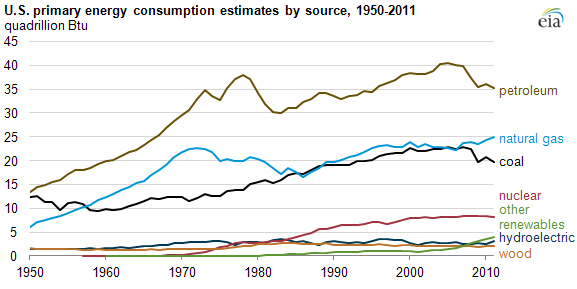Introduction

(Graph obtained from: https://www.eia.gov/todayinenergy/images/2012.12.14/consumption.png)
In recent years, we have become increasingly concerned about the rate of consumption of non-renewable sources of energy. As seen in the graph above, there has been an increasing trend in (US) consumption of petroleum since the mid-1900’s. This trend is seen all across the globe and it is unsustainable as petroleum is a non-renewable source of energy. It will ultimately result in an energy crisis. With this impending crisis in mind, research has been conducted to develop alternate and renewable sources of energy. The aim of such research is to decrease the rate of depletion of non-renewable energy sources.
In this blog, we will focus on a less common use of Ethanol — its role as a biofuel.
Ethanol is a clear, colourless liquid and it is the principal type of alcohol found in alcoholic beverages. It is also known as alcohol, ethyl alcohol, and drinking alcohol. It is a volatile, flammable, and colourless liquid with a slight characteristic odour. Its chemical formula is CH3CH2OH or C2H6O, and is often abbreviated as EtOH. Even though Ethanol is widely known for its alcoholic properties, it has a variety of other uses. Ethanol has the same chemical formula produced from biomass. Biomass refers to starch- and sugar-based feedstocks such as corn, grain, sugar cane, and cellulosic feedstocks.
The Process of Converting Ethanol to Biofuel
Step 1:
Biomass feedstocks are grown, harvested and transported to an ethanol production facility.
Step 2:
Feedstocks are converted to ethanol at a production facility and transported to a fuel terminal or end-user. The process can be seen below:

Image 2: Process of converting starch to ethanol
Step 3:
Ethanol is blended with gasoline at the fuel terminal to create the different type of fuels, namely E10, E15, or E85, before being distributed to fueling stations.
Properties of Ethanol for Biofuel
Ethanol has a higher octane number than gasoline, providing it premium blending properties. Lower octane numbers prevent engine knocking and ensure smooth driving. Ethanol contains less energy per gallon than gasoline to varying degrees, depending on the volume percentage of ethanol in the blend. Denatured ethanol (98% ethanol) contains about 30% less energy than gasoline per gallon. Ethanol’s impact on the fuel economy is dependent on the ethanol content of the fuel.
Energy released
When ethanol reacts with oxygen, combustion occurs. During this reaction, a large amount of energy is released. When ethanol is burned, it turns blue, which is a sign of chemical reaction. Carbon dioxide (CO2) and water (H2O) are produced from this reaction.
Ethanol that is primarily produced from starch found in corn grain demonstrates a positive energy balance, meaning that the production of feedstock and fuel does not require more energy than is contained in the fuel.
On the other hand, Cellulosic ethanol improves the energy balance of ethanol. This is because cellulosic feedstocks require less fossil fuel energy to produce ethanol. Biomass that is used to power the process of converting non-food-based feedstocks into cellulosic ethanol also reduces the amount of fossil fuel energy used in production. Another benefit of cellulosic ethanol is that it results in lower levels of greenhouse gas emissions making it a greener fuel.
With the two example stated above, we can see that the combustion of ethanol produces energy and how the different sources of ethanol affect the amount of energy produced by the combustion of ethanol.
Biofuel vs Traditional fuel

Image 3: Table showing the energy output of different types of fuels.
As seen in the above table (image 2), when we compare Ethanol to other commonly used fuels such as Diesel oil, we see that the energy output of ethanol (1375.01 KJ/mol) falls greatly behind the energy output of Diesel oil (10123.99 KJ/mol). This shows that while ethanol can be used as biofuel, its energy output pales in comparison with the other alternatives that we currently have.
References:
1. Home. (n.d.). Retrieved March 25, 2017, from https://abhsscience.wikispaces.com/Combustion of Ethanol
2.Ethanol Fuel Basics. (n.d.). Retrieved March 30, 2017, from http://www.afdc.energy.gov/fuels/ethanol_fuel_basics.html
3.Interactive Student Tutorial. (n.d.). Retrieved April 01, 2017, from http://wps.prenhall.com/wps/media/objects/4678/4790699/ch08_12.htm
4.How is ethanol made? (n.d.). Retrieved April 02, 2017, from http://biofuelsassociation.com.au/biofuels/ethanol/how-is-ethanol-made
